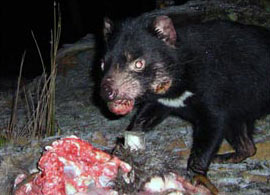| “塔斯马尼亚恶魔”的死亡之谜(图) |
| http://www.sina.com.cn 2005/03/31 19:28 国际在线 |
Starting in the late 1990s Tasmanian wildlife authorities began receiving unusual reports: Some of the island's Tasmanian devils were spied with their faces marred by ulcerated sores. Small and furry, the carnivores are known for their unearthly howl and cranky temperament. They are also well loved as a species unique to Tasmania, an island outpost calved from mainland Australia. But what was initially a bit of a scientific curiosity soon became a potential catastrophe. The results of the first investigative survey revealed that tens of thousands of Tasmanian devils had died from a disease now known as Devil Facial Tumor Disease. Alistair Scott is a project leader for the devil disorder program at Tasmania's Department of Primary Industries, Water, and Environment. He says that initial survey revealed that the disease was running rampant through the eastern half of Tasmania. "Mapping and monitoring showed it was across 65 percent of the state," Scott said. "The maximum population estimate [before the disease struck] was between 130,000 and 150,000. So from that, we believe we've lost up to 75,000. This has had a major impact on the devil population.'' Devil Facial Tumour Disease causes cancers to appear first in and around the mouth before spreading down the neck and, sometimes, into the rest of the body. Both male and female adults are more commonly affected than juveniles. Sick devils also become emaciated, because the tumors interfere with eating, and many mothers lose their young. The animals can die within six months of the appearance of the first sores, and in some areas whole populations have been wiped out within 18 months. A special Tasmanian devil-dedicated laboratory has been set up in the northern town of Launceston, where scientists are desperately trying to work out what causes the disease and how it is transmitted. "At the moment the scientists are working on the hypothesis that the disease is physically transferred," Scott explained. "That has only been recorded once before in the animal world, and that was a venereally transmitted canine cancer. It's a unique disease we're dealing with. Once it's detected—and even then, that is only visually—the animal is on death row. They are dead three to six months later." The team is working on the disease's chromosome structure and has just identified the karyotype. (Karyotypes are pictures of cellular chromosomes that are used to check for abnormalities.) The researchers say they have also been able to develop tumor cells in the lab, enabling them to run tests without actual tumors. A diagnostic test and, ultimately, a vaccine are the scientific team's main aims. But while the scientists race to learn more about the disease, the Tasmanian government is trying to stop the disease from spreading further. To stop infected animals from moving in, trapping lines are being set in the north of Tasmania, an area that so far appears to be disease free. The government is also considering whether to list the species as threatened under Australia's threatened-species laws. Threatened status would give the devils protection from other perils, such as habitat destruction caused by water pollution or land development. The move would also require the government to draw up a plan for recovery of the species. Such a plan would focus on managing the disease where it already exists and on preventing it from affecting more animals. The disease "is having a very serious impact on the wild population, but at this stage we don't believe that the species is headed for extinction," Scott said. "In the areas where it has been present but [where] there's only a low level population, it has had a major impact. One of the problems is that the devil is nocturnal, and many people never see it in the wild. So it's very difficult to pick up changes in the population.'' |
| “塔斯马尼亚恶魔”的死亡之谜(图) |
自从上个世纪90年代末,澳大利亚塔斯马尼亚岛的野生动物官员们就陆续接到一些不同寻常的报告,这些报告显示,一些被称之为“塔斯马尼亚恶魔”的有袋动物——袋獾的面部都出现了严重溃烂的伤口。 据美国《国家地理》杂志网站3月29日报道,袋獾是全世界体型最大的肉食性有袋哺乳动物,同时也是澳大利亚塔斯马尼亚岛特有的生物种类。袋獾以它那独特的嚎叫声和暴躁的脾气著称于世,塔斯马尼亚最早的居民因为被夜晚远处传来的袋獾可怕的尖叫声吓坏了,因此称它们为“塔斯马尼亚的恶魔”。 但是,自从上个世纪90年代以来,“塔斯马尼亚恶魔”却遭遇到了真正的“魔鬼”。一些最初的调查结果显示,有数万只的袋獾因为感染上了一种名为“袋獾面部肿瘤”(Devil Facial Tumor Disease)的疾病而死亡。 艾里斯泰尔·斯科特是塔斯马尼亚农业部门一个袋獾研究项目的负责人。他介绍说,初步的研究显示,这种奇怪的面部肿瘤疾病正在塔斯马尼亚东部迅速蔓延。他说:“监控结果显示,这种奇怪的疾病已经遍及了塔斯马尼亚州65%的地区。在这种疾病出现之前,袋獾最多时的数量约达到13万至15万只。而现在,已经有大约7.5万只袋獾因为患上这种疾病而死亡,这对塔斯马尼亚地区袋獾的整体数量无疑产生了巨大的影响。” 得了这种怪病之后,袋獾会首先在嘴部周围出现毒瘤,然后肿瘤会慢慢扩散至颈部,有时候还会出现在身体的其它部位。成年袋獾较之幼年袋獾更容易患上这种疾病。同时,因为肿瘤会干扰到袋獾的进食,所以生病的袋獾通常会变得非常衰弱,这个时候,雌性的成年袋獾就很容易丧失它们的幼仔。在溃烂的伤口出现后,袋獾会在6个月之内死亡。在塔斯马尼亚的某些地区,所有的袋獾会在短短18个月内丧命于这种可怕的疾病。 目前,一个专门的袋獾实验室已经在塔斯马尼亚的北部城镇朗塞斯顿建立起来。科学家们希望在实验室中能找到这种神秘疾病的起因以及它不为人知的传播方式。现在科学家们是基于“这种疾病是靠身体接触传播”的假设进行研究工作的。斯科特说,在动物界中,以前惟一有过记载的一次是一种通过交配传播的犬类恶性肿瘤,而这也是他们在研究工作中所涉及到的惟一一种疾病。目前,研究人员正在分析这种疾病的染色体结构,并已识别出它的染色体组型。 研究者表示,他们已经能够在实验室里培养这种肿瘤细胞,并能对它进行测试。对这种疾病作出正确的诊断并最终能研制出相关的疫苗是这个科研小组的主要目的。目前,研究者正致力于了解关于这种疾病的更多知识。塔斯马尼亚政府也在努力地采取一些措施,希望能阻止这种疾病进一步蔓延。 为了阻止这种疾病的快速传播,一道防护线正在塔斯马尼亚北部地区建立起来,现在塔斯马尼亚北部地区是至今为止还没有受这种可怕疾病影响的地区。同时,塔斯马尼亚政府也在考虑是否将袋獾这种动物作为濒危物种列入澳大利亚的《濒危物种法》。这一举措将使袋獾受到人们的保护,从而免受其它危险因素(如因为水质污染或土地开发而使其栖息地遭到破坏等)的干扰。同时,这也要求当地政府起草一份关于袋獾种群恢复的计划书,这份计划书应该着重于控制已经发生的疾病,并同时防止它传播给更多的动物。 对此,斯科特表示,这种疾病“已经给野生的袋獾种群造成了非常严重的影响,但科学家们相信,在眼下这段时期内,袋獾还不会从塔斯马尼亚的栖息地灭绝。 目前,塔斯马尼亚岛上袋獾面临的窘困局面也惊动了澳大利亚大陆的相关人士。澳大利亚的野生动物保护区和一些动物园也联合起来,开始就有关事宜进行讨论。如果塔斯马尼亚岛上野生袋獾的生存情况继续恶化,那么圈养的袋獾会被人们送到澳洲大陆。目前,澳大利亚大陆和塔斯马尼亚岛上共生活着大约150只圈养的袋獾。(作者:王高山) |
|
|
|
|
|
| Annotation |
| 新 闻 查 询 |
| 热 点 专 题 | ||||
| ||||
|
教育频道意见反馈留言板 电话:010-82628888-5747 欢迎批评指正
新浪简介 | About Sina | 广告服务 | 联系我们 | 招聘信息 | 网站律师 | SINA English | 会员注册 | 产品答疑
Copyright © 1996 - 2005 SINA Inc. All Rights Reserved
版权所有 新浪网![]() 北京市通信公司提供网络带宽
北京市通信公司提供网络带宽
